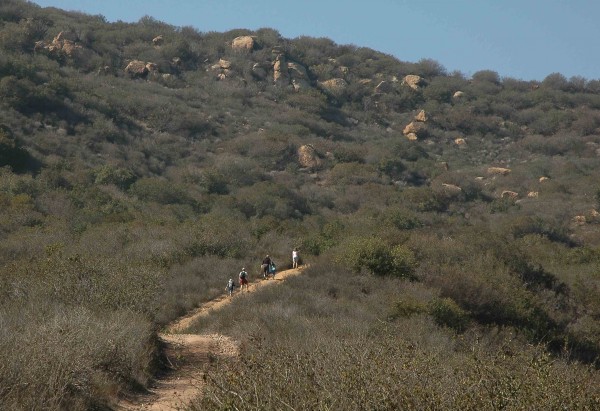
In rejecting adding new traffic lanes to Laguna Canyon Road, the City Council Tuesday instead endorsed pursuing a minimalist approach to improving the town’s often congested primary corridor, a position supported in vociferous testimony by many of the more than 50 residents present.
“We are for maintaining the current traffic lanes, expanded pedestrian access, undergrounding of utilities, and no acceptance of grant funds that expand vehicle lanes,” said Barbara Miller and Joanna Felder from Village Laguna, an organization committed to preserving the town’s village character. And that definitely was the consensus voice of most present.
The report was the culminating effort of nine meetings by the Laguna Canyon Road Task Force, which spent more than two years investigating a swath of issues bedeviling potential improvements along Laguna Canyon Road, including: congestion, access for pedestrians and bikes, increasing flow and mobility of all traffic types and preserving the character of the Canyon. The stretch of roadway between El Toro Road and Canyon Acres Drive, also known as state Highway 133, is under the authority and direction of the state Department of Transportation. “Part of this process was to work with Caltrans on how best to facilitate improvements to Laguna Canyon Road,” said Christa Johnson, assistant city manager.
The report outlined multiple alternatives, possibilities and approaches, identified by individual letters. “Based on what we heard tonight, I believe we should make a community statement and reject alternatives A, B, C, and D,” said Mayor Pro-Tem and Councilmember Steve Dicterow.
Applause resonated loudly after the Councilmember’s statement with anxious onlookers ready to buttress his remarks with support. “No one wants A, B, C or D,” said long-time resident Arnold Hano. “We should try to stay as close as possible to what we have.”
The rejected alternatives (A, B, C and D) suggested broadening Laguna Canyon Road in some variation from its current configuration, one lane north and south with a center turn lane, to as many as four lanes. “There should be no road widening and no additional paving of expanded vehicle lanes,” said Carol Nilsen of Let Laguna Vote, a bipartisan group of concerned community residents.
Choices favored by the public included E, F and G, which would keep the traffic lanes as currently configured, but would encourage pedestrian and bike access on dedicated bike and pedestrian paths of between 6 and 12 feet wide. Another possibility discussed would be for a hybrid public transportation lane, which could include a shared dedicated lane.
“Laguna has many unique issues, but traffic congestion is not one of them, and we cannot expect to solve congestion in isolation,” Let Laguna Vote chair Rita Conn said in a letter urging supporters to participate in the meeting. “Task force alternatives E, F, and G, comprising many desired components of canyon road improvements, are accepted, and these are the plans whose elements Let Laguna Vote endorses.”
Canyon Alliance of Neighborhoods Defense Organization President Penelope Milne joined the chorus against expansion. “We are against any additional traffic lanes,” she said. “We support protection of our open space and encourage public transportation.”
Residents were equally championing of the task force recommendation to “undergrounding” utilities along the roadway. “Undergrounding utilities should be one of the Council’s priorities. Open space should not be used for widening; those areas should be protected,” said Gene Felder, speaking on behalf of Carolyn Wood, president of Laguna Canyon Conservancy, dedicated to preserving the canyon’s natural habitat.
Mayor Bob Whalen, a task force member, indicated his strong support for seeking an estimate from Southern California Edison for burying the utilities along the roadway. “The high transmission lines are the biggest hurdle, but the lines on the west side of the road may be quicker, “he said.
Despite overwhelming consensus among residents present on how the Council should proceed, that still left unresolved how to address future use of Laguna Canyon Road.
Johnson pointed out that, “38,000 to 42,000 vehicles travel on Laguna Canyon Road each day; 60 percent of this traffic is pass-through, which means it has no start or final destination in Laguna Beach.” Those figures will grow as population increases in the next 20 years, the report predicted. “We need to come to a broad-based public consensus. Is this worth the cost and time?” asked Councilmember Dicterow.
“We don’t want to send Caltrans anything that we don’t want to live with,” said Councilmember Toni Iseman, also a task force member.
From planning to final construction, no matter which alternative is ultimately selected, the timeline could be nine to 11 years. Further cost estimates on a yet unknown and undecided upon project could reach into the hundreds of millions of dollars, a point raised by City Manager John Pietig.
Councilmembers debated the nuances of the six proposed recommendations. “There should be one-lane in each direction,” said Councilmember Dicterow.
“Safety is one of the primary concerns in this decision,” said Councilmember Rob Zur Schmiede.
The Council voted unanimously to approve a feasibility study for Laguna Canyon Road, which would include right-of-way access, drainage and traffic analysis along the corridor.
In addition, the Council asked staff to inform Caltrans of its intentions and to seek grants from the agency for cost-sharing on the study as well as to seek cost estimates from Edison for burying utility poles along the road.
“The road is an introduction to Laguna Beach and we don’t want to lose it,” said audience member Jennifer Zeiter.





[…] Breeze, negotiations with Heritage LLC, task-force recommended improvements to Laguna Canyon Road and a voter-approved hike in bed taxes, all are driven by the same force, […]